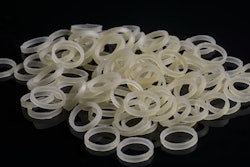
Patients who experience trauma such as wisdom teeth extractions may develop temporomandibular disorders (TMD), according to a review published recently in Cranio: the Journal of Craniomandibular and Sleep Practice.
Although the association does not equal causation, there is a presurgical incidence of TMD in the patients seeking third molar extractions.
“[Therefore], the importance of including a full temporomandibular joint pre-surgical assessment may lead to a reduced incidence of TMD in this patient population,” wrote author Dr. Dennis Marangos, a private practice dentist in Toronto, Canada (Cranio, June 28, 2023).
Wisdom teeth extraction is one of the most common dental procedures, with about 10 million third molars removed each year. Some evidence has shown that the removal has become the norm because humans' faces and jaws have become smaller, thanks to the development of processed foods over generations. With no room or need for wisdom teeth, it’s possible this led people to have underdeveloped cranial structures and predisposed them to TMD, according to the editorial.
Since it is common for patients to complain about jaw pain and clicking after third molar surgery, Marangos reviewed past studies about the possible relationship between extractions and TMDs. The goal was to offer a casual analysis of the literature and provide considerations for practice and not an exhaustive systematic review, the author wrote.
TMD is primarily a condition that affects young and middle-aged adults, specifically women. Clinically, most patients who need third molar surgery fall into this same age group.
One previous study revealed that patients referred for third molar surgeries show signs of temporomandibular joint (TMJ) disorders. About 40% of the patients had at least one clinical sign of a potential TM joint disorder, Marangos wrote.
Wisdom teeth extractions are classified as a macro trauma, which is a type of injury caused by external force involving large or excessive forces. Compared to controls, patients exposed to third molar surgery were at higher risk of developing TMD; another study suggested that these extractions are a risk factor for developing TMD.
Additionally, in the literature, it was concluded that TMD can be aggravated depending on the location of a third molar, the degree of impaction and surgical difficulty, age, and gender. However, the author wrote that there was an insignificant risk of TMD six months after extractions.
In the studies, the use of excessive force during third molar surgeries was a common theme. In one example, the prevalence of TMJ injuries after student extractions of third molars was between 50% and 63%. In a different study, only 16% of the patients reported severe TMD pain post-surgery that were performed by oral surgeons, according to the review.
With all of this in mind, clinicians should complete TMJ preprocedural assessments, which consider details like risk factors and anatomical limitations, prior to performing third molar surgeries, the author wrote.
“We can safely say that trauma may lead to TMD,” Marangos wrote.




















